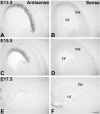Application of in utero electroporation of G-protein coupled receptor (GPCR) genes, for subcellular localization of hardly identifiable GPCR in mouse cerebral cortex
- PMID: 25078448
- PMCID: PMC4132308
- DOI: 10.14348/molcells.2014.0159
Application of in utero electroporation of G-protein coupled receptor (GPCR) genes, for subcellular localization of hardly identifiable GPCR in mouse cerebral cortex
Abstract
Lysophosphatidic acid (LPA) is a lipid growth factor that exerts diverse biological effects through its cognate receptors (LPA1-LPA6). LPA1, which is predominantly expressed in the brain, plays a pivotal role in brain development. However, the role of LPA1 in neuronal migration has not yet been fully elucidated. Here, we delivered LPA1 to mouse cerebral cortex using in utero electroporation. We demonstrated that neuronal migration in the cerebral cortex was not affected by the overexpression of LPA1. Moreover, these results can be applied to the identification of the localization of LPA1. The subcellular localization of LPA1 was endogenously present in the perinuclear area, and overexpressed LPA1 was located in the plasma membrane. Furthermore, LPA1 in developing mouse cerebral cortex was mainly expressed in the ventricular zone and the cortical plate. In summary, the overexpression of LPA1 did not affect neuronal migration, and the protein expression of LPA1 was mainly located in the ventricular zone and cortical plate within the developing mouse cerebral cortex. These studies have provided information on the role of LPA1 in brain development and on the technical advantages of in utero electroporation.
Keywords: GPCR; cerebral cortex; in utero electroporation; lysophosphatidic acid; lysophosphatidic acid receptor-1.
Figures






References
-
- Aboitiz F, Morales D, Montiel J. The inverted neurogenetic gradient of the mammalian isocortex: development and evolution. Brain Res Brain Res Rev. 2001;38:129–139. - PubMed
-
- An S, Bleu T, Hallmark OG, Goetzl EJ. Characterization of a novel subtype of human G protein-coupled receptor for lysophosphatidic acid. J Biol Chem. 1998;273:7906–7910. - PubMed
-
- Bandoh K, Aoki J, Hosono H, Kobayashi S, Kobayashi T, Murakami-Murofushi K, Tsujimoto M, Arai H, Inoue K. Molecular cloning and characterization of a novel human G-protein-coupled receptor, EDG7, for lysophosphatidic acid. J Biol Chem. 1999;274:27776–27785. - PubMed
Publication types
MeSH terms
Substances
LinkOut - more resources
Full Text Sources
Other Literature Sources
Miscellaneous

